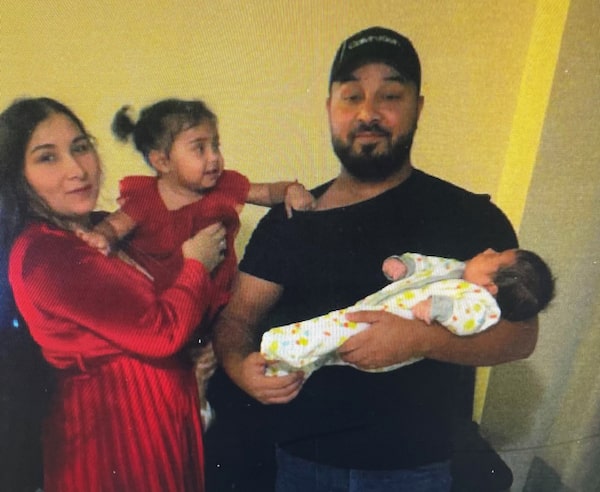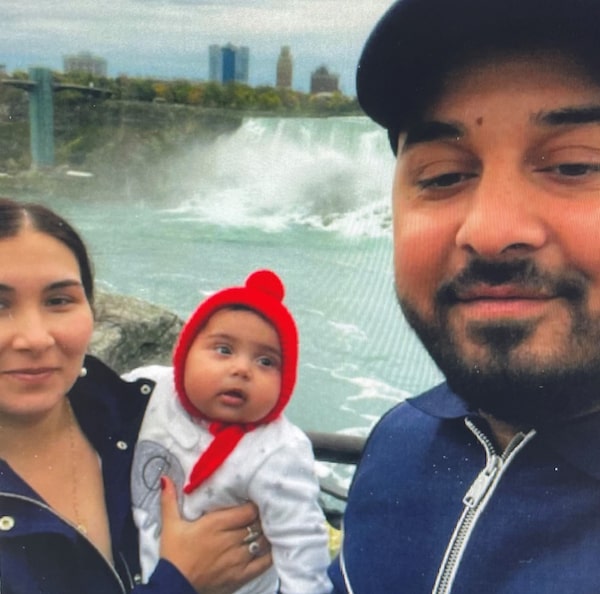
Florin and Cristina Iordache pictured with their children Evelin and baby Elyen. The family feared deportation in Canada and drowned in the St. Lawrence River in an attempt to make it to the U.S.Courtesy of family
After the discovery of eight migrant bodies in the St. Lawrence River earlier this year, one image emerged that felt especially haunting, even amid all of the horror and details of lives lost. It was a photo of two of the victims taken before their deaths. Both of them were small children: Evelin, a toddler with round cheeks in a red dress, and her brother Elyen, an infant in a onesie, with a thick crop of dark hair.
Their parents, Florin and Cristina Iordache, were refugee claimants from Romania. They had been in Canada for six years, and Evelin and Elyen were born here. But by late March, 2023, the parents were on the verge of being deported.
The family faced a wrenching decision: Either split up, leaving the Canadian-born children behind (if possible, with family or friends, or in foster care) or take them to Romania, where an uncertain but likely grim future awaited.
They chose neither. Instead, the Iordaches boarded a boat operated by a human smuggler in an attempt to enter the United States. All of them died.
In the immediate aftermath, politicians expressed shock that Canadian citizens – children, no less – were not better protected by our institutions.
“Any kid is troubling, but the fact that there’s two Canadian kids who perished in this way brings it home,” the family’s lawyer Peter Ivanyi said at the time.
Prime Minister Trudeau called the family’s plight “horrific.” Canada, he said, “must remain open and welcoming, with a rigorous and well-applied immigration system that protects the most vulnerable.”
But in conversations with migrant advocates, lawyers and settlement workers, all of them echoed the same sentiment: The situation the Iordache family faced was not exceptional. Parents without status routinely face the threat of deportation, despite the excruciating dilemma it creates in regards to their Canadian-born children. Most children are left with little option but to leave the country too.
“Imagine that kind of Sophie’s choice,” said Rachel Kronick, a McGill University professor and child psychiatrist who works with refugee families.
“The trauma of separation. Or putting them potentially in harm’s way. These are just unbearable decisions for parents to make.”

Florin and Cristina Iordache with Eleyn.Courtesy of family
The byzantine and slow-moving processes of the immigration system is often a major contributing factor, critics say. As of last month, more than two million applications were awaiting processing with Immigration, Refugees and Citizenship Canada.
“Procedures here frequently take years to reach finality,” said Andrew Brouwer, senior counsel in refugee law at Legal Aid Ontario. And while families wait, they continue on with their lives, finding work, building homes and sometimes having kids.
Nuria Branco came to Canada in 2016, joining her common-law partner, João Fagundes. He had arrived from the Azores two years earlier, initially as a visitor, and began the process of applying for permanent residence at that time under the skilled-trades program (Mr. Fagundes is a roofer). The federal government’s service standard for such applications is six months.
The couple has made repeated attempts to gain legal status since, first paying a lawyer $15,000 to apply for permanent residency, only to learn the program he’d promised didn’t exist. They later spent an additional $16,000 on “legal fees” with an individual who, it turned out, wasn’t even a lawyer.
Amid this long process, Ms. Branco gave birth to their daughter, Alline. She was born in 2018 with a number of health complications, including cerebral palsy, and required constant care from a range of specialists. A year later, Mr. Fagundes was issued a deportation order.
“As soon as they told us, our world fell,” Ms. Branco said. They agonized over the medical care Alline would receive in the Azores; here, the same team of specialists and experts had been caring for her since birth. Plus, without Portuguese citizenship, she’d likely face a long wait before becoming eligible for health care. They stopped sleeping, and were afraid to leave the house for fear they would be stopped and asked for documentation.
“We didn’t know what was going to happen with Alline, with us – with her future.”
The United Nations Convention on the Rights of the Child, of which Canada is a signatory, explicitly dictates that “the best interests of the child shall be a primary consideration in all actions concerning children.”
But in practice, advocates say, this principle isn’t consistently applied in immigration programs.
When assessing a refugee application, for instance, the existence of Canadian-born children is not a required consideration. And in cases where a deportation order has already been issued – and where a family makes a deferral request – officials are required to factor in only the short-term interests of a child.
“We understand that these sorts of situations are incredibly difficult and do empathize with the families,” IRCC spokesperson Michelle Carbert said.
She referred to a separate option called a humanitarian and compassionate application. The H&C process does assess families based on the best interests of children. But it can be a high bar, advocates say, and is meant only for “exceptional” cases. The rejection rate rose to nearly 70 per cent in early 2021, from about 36 per cent in 2016.
H&C applicants can also wait years for a decision, and there’s nothing preventing officials from deporting parents in the meantime.
Part of the issue, said Toronto-based immigration lawyer Lev Abramovich, is that the government wants to protect against fraudulent claims and so-called “anchor babies” – concerns around foreigners, usually wealthy, using children born in Canada as a shortcut to citizenship.
But while fraud does happen, it’s the government’s job to target that systemically, by going after the criminal or fraudulent organizations who look to exploit our systems, he said.
Instead, “right now, the people we’re punishing are individuals.”
When it comes to H&C applications, a family’s financial situation also plays a role.
Each legal application can cost several thousands of dollars – and that’s before legal fees. Filing an additional H&C application – another several thousand dollars – is an option that many people can’t afford.
“In theory, there are avenues in the law,” Toronto immigration lawyer Warda Shazadi Meighen said. “But it takes resources.”
Last year, the UN’s Committee on the Rights of Children took to reminding Canada of its treaty obligations. The best interests of the child, it said in a report, must be “appropriately integrated, into, and consistently interpreted and applied,” across all policies and programs.
In a statement, Karine Martel, a spokesperson for the Canada Border Services Agency (which is responsible for immigration enforcement), said that the government “seeks to balance its UN obligations while adhering to legislative requirements when administering cases involving minor children.”
The decision to deport anyone, she said, “is not taken lightly,” and “always considers the best interest of the child.” She cited the exceptions CBSA officers sometimes make to grant families facing deportation additional time, so that a child can finish their school year or attend medical appointments.
But many families, like the Iordaches, simply run out of options.
At that point, said Syed Hussan, the executive director of Migrant Workers Alliance for Change, some families choose to go undocumented. But this puts them at risk of exploitation – from their employers, or even trafficking operations. It also means uprooting the children from their lives to avoid being caught by immigration officials: moving to a new home, new school and new job.
“They remain in Canada undocumented, facing exploitation and abuse and denial of service, because that seems like a better option,” he said.
But most families, experts say, choose to leave together – with the Canadian-born children – uprooting their lives for an uncertain future in an often-unknown country.
Many of the refugee families who find themselves in this situation have already endured trauma before coming to Canada, Dr. Kronick said. So the threat of deportation or separation becomes an additional blow. And these cumulative traumas can put families – and children – at higher risk of developing anxiety, depression or post-traumatic stress disorder. “The more the trauma builds and accumulates, the harder it is to recover.”
Because the government does not track data on how often the situation arises, she called it an “invisible cruelty.”
On a regular basis, she said, “what I see are families having to choose between separation and safety.”
Last month, the Canadian Academy of Child and Adolescent Psychiatry released a paper urging the federal government to enshrine all aspects of the “best interests of the child” principle into immigration policy.
In practice, what they’re asking is for officials to put in place an additional process any time a deportation order that may affect children is considered.
This, Dr. Kronick said, would require officials trained in assessing child welfare (not simply CBSA agents) to ask questions about the impact on the child’s development: “What’s at stake in terms of their mental health? What’s at stake in terms of their right to family unity?”
Mr. Brouwer, the Legal Aid Ontario lawyer, described it as “flipping the onus” on government.
“If the policy were designed with an eye to, ‘How is this going to affect the best interests of the child?’ maybe we wouldn’t have people forced into these very dangerous situations, and dangerous border crossings, with children.”
But Mr. Syed, the migrant worker advocate, said these reforms don’t go far enough. In 2022, Canada granted permanent residence to fewer than half a million people. In the same year, the country issued around 1.2 million temporary work and study permits.
“That’s the straight math,” he said. “We’ve created a system of permanent temporariness.”
The migrant workers who make up his organization tell him, “‘We’re like chewing gum,’” he said. “You bring us here, you chew us. And then when you’re done, you toss us out.”
Instead, he said, the government should be granting permanent resident status as the default for the majority of people entering the country. He’s also pushing for Ottawa to regularize the status of undocumented people – a one-time move that would grant permanent residence to those already living here. It’s an option the government has said it’s considering.
But there’s no timeline on when that might happen.
Ms. Branco and her family, at least, have received happy news. They eventually found their way to Ms. Shazadi Meighen, the Toronto-based immigration lawyer, who was able to secure permanent resident status for the couple last July.
They did this using an H&C application, which was successful largely because of Alline’s extraordinary circumstances. They were able to include letters from doctors describing her medical needs. They also submitted a letter from a Portuguese official describing the long delays Alline would face in receiving care there, and the “deleterious” effects that would have on the young girl’s development.
With that immediate threat out of the way, Ms. Branco has been able to devote her attention fully to Alline’s care: the thrice-weekly physiotherapy appointments and the many regular trips to hospital for assessments. For years, the couple had been balancing all that with what often felt like the full-time work of pursuing legal status.
These days, Alline can crawl and say a number of words, including “five” (her age) and “mommy.” She showed off these skills proudly to a visitor one recent afternoon, scooting across the kitchen floor in pursuit of orange jelly candy.
Ms. Branco watched from a few steps away. “Before we became permanent residents, we were always fighting – to make sure we were doing everything,” she said.
“Now, we can rest.”
 Ann Hui
Ann Hui